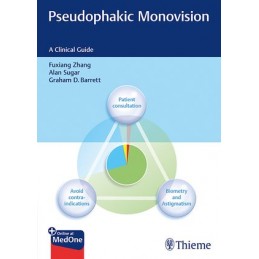- Reduced price

Order to parcel locker

easy pay


 Delivery policy
Delivery policy
Choose Paczkomat Inpost, Orlen Paczka, DHL, DPD or Poczta Polska. Click for more details
 Security policy
Security policy
Pay with a quick bank transfer, payment card or cash on delivery. Click for more details
 Return policy
Return policy
If you are a consumer, you can return the goods within 14 days. Click for more details
A state-of-the-art resource on successful management of intraocular lens monovision
Pseudophakic Monovision:: A Clinical Guide by renowned ophthalmologic surgery experts Fuxiang Zhang, Alan Sugar, and Graham Barrett reflects decades of robust academic research, with comprehensive discussion of the pseudophakic lens. Pseudophakic monovision is frequently used as a strategy for presbyopia correction in cataract surgery patients, with high satisfaction rates. The authors address the advantages and drawbacks to this approach, with topics ranging from the optics and neurophysiology of monovision to preoperative vision testing and counseling. The book fills a gap in the literature on this essential yet relatively neglected topic.
In the current era of an ever-expanding array of intraocular lenses inserted in cataract surgery, monovision correction is emerging as an efficacious, far less expensive method for managing presbyopia than multifocal lenses. One eye is corrected for optimal distance vision and the other for optimal near vision, thereby avoiding both the expense of multifocal lenses and inconvenience of wearing glasses and/or contact lenses. Emerging adjustable IOLs address eye dominance issues, enabling patients to attain excellent distance acuity in one eye, then select the amount of myopia that works best in the second eye.
Key Features
This invaluable resource will help refractive cataract surgeons incorporate Toric, accommodating, and EDOF IOL technology into ophthalmology practice and achieve excellent patient outcomes.
This book includes complimentary access to a digital copy on https://medone.thieme.com.
Data sheet
1 Introduction
2 Optics and Neurophysiology of Pseudophakic Monovision
3 Non-Pseudophakic Monovision
4 Pseudophakic Monovision
5 Ocular Comorbidities and Pseudophakic Monovision
6 Special Situations
7 Limitations of Pseudophakic Monovision
